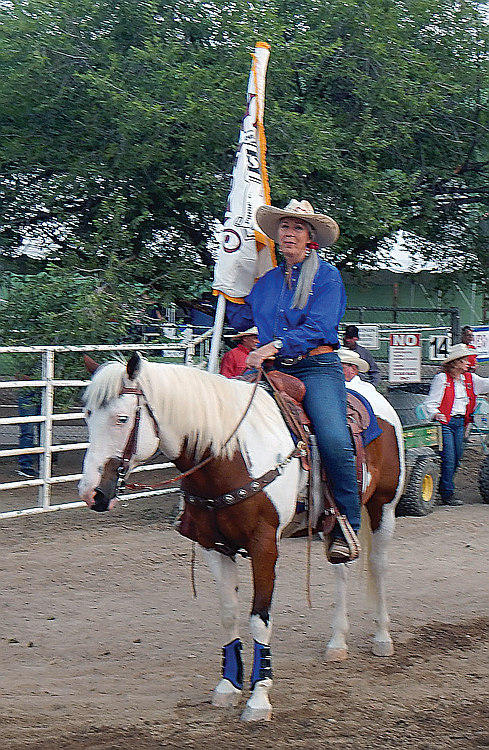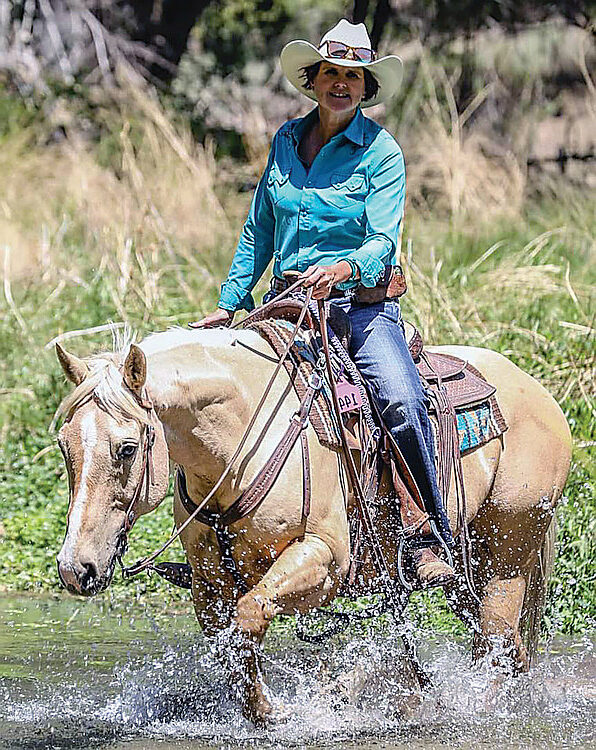By Rita Thompson-Tinsley
Horseback riding ranks top among several sports when it comes to serious injuries. According to horse riding accident statistics in 2023, horseback riding is more dangerous than skiing and motorcycling and is the leading cause of sports-related traumatic brain injuries. Although head and neck injuries are the most common result of horse riding accidents, equestrians can suffer other inflictions, physically and emotionally.

Diane Judge has been a part of rodeos in Tucson, Prescott, and Flagstaff administratively, as well as riding in the World’s Oldest Rodeo Grand Entry.
During the summer of 2021, as horses lined up preparing to enter the rodeo arena, Judge took her place mounted on her paint horse, Blue Eyes.
Moments before the start, a rider struggling with his horse joined the lineup. As he continued to grapple with his horse, it swiftly turned, clipped Diane’s leg, and went flying into Blue Eyes. Diane’s horse bolted out of the lineup as she continued to ride, maneuvering him in ways to calm his spirit.
When a beverage cart appeared, blocking the alley way, her panicked horse made a 90-degree turn propelling Diane into the back of the flatbed cart. Judge dusted herself off and remarkably completed the Grand Entry with a properly composed Blue Eyes.
Weeks later, after suffering relentless pain, Diane was diagnosed with a dislocated shoulder, multiple bone bruising, and soft-tissue damage.
It would be two years before Judge would recover enough to ride again. But though her body had been healing, her fears began mounting.
After so much pain, the thought of falling again was unbearable. But Diane got back in the saddle and continues to enjoy smaller rides with a tighter circle of friends.
Horse trainer Josh Reynolds has been working with horses for years. He has started young horses and works with all sorts of breeds and situations. He uses proven methods from trainers such as Clinton Anderson.

Last May, Josh was working with a mare who showed a lack of confidence. He started slowly with lots of ground work, as safety is paramount in his training business. Eventually, Josh advanced to working her in the saddle.
He was riding the mare from a busy road when something startled the horse. She began bucking, and Josh counted three bucks before he executed an unavoidable aerial flip and landed on his back. The horse marched home solo as Josh struggled to get off the ground.
Josh suffered a fractured L1 and L2 and could only rest in a recliner for weeks. He isn’t hesitant about returning to working horses. However, Josh expresses apprehension about working with that particular mare.
Summer 2011, Susan Shuford joined friends on a horse camping expedition in New Mexico’s Gila National Forest. On day one, not more than twenty yards from camp, the riding group approached a narrow stream surrounded by overgrown willows. Susan’s three-year-old palomino, Bo, had not yet experienced creek crossings.
When the horse in front refused to go, Susan forged around that horse knowing that her super-chilled gelding would be willing to adhere to her cues. When Bo refused to cross and whirled away in the opposite direction, Susan spent time working Bo, having him do exercises that would bring his focus back to her.

Susan rode Bo back to the crossing. When Bo again refused, she spurred him to go forward. Bo exploded into rodeo-sized bucks, eight of which she rode out until being propelled over Bo’s head where, she declares, “I went down like a lawn dart,” and plummeted to earth headfirst.
Due to the remote location, her companions couldn’t phone for help. When a nearby resident drove by, they offered to drive Susan’s friend Stan to their home where they had a satellite phone. A helicopter life-flighted Susan to a trauma center in Tucson.
Still in a coma, she was diagnosed with a traumatic level three brain injury, three brain bleeds, and multiple broken ribs. The neurosurgeon told Susan’s husband Mike that she would never ride again and might never walk. Thirteen hours later she awakened. After years of therapy, she became functional.
Her trusty farrier, Rex, took horse Bo to his place. Every Sunday, Mike took Susan to visit Bo.
Close to a year and a half later, Susan had Rex lift her onto Bo’s back. Rex then guided Bo and her around like a child’s pony ride.
In 2013, Shuford was slowly able to saddle and ride. In 2015, she attended her first horse event after the accident.
“I’m not the same rider physically as I was, but I am the same rider intensely,” said Susan, determined and driven.
Susan still contends with hearing loss, double vision, and balance issues, but doesn’t want to miss a moment, an experience, a sunset, or a sunrise.
~ By Rita Thompson-Tinsley ~


